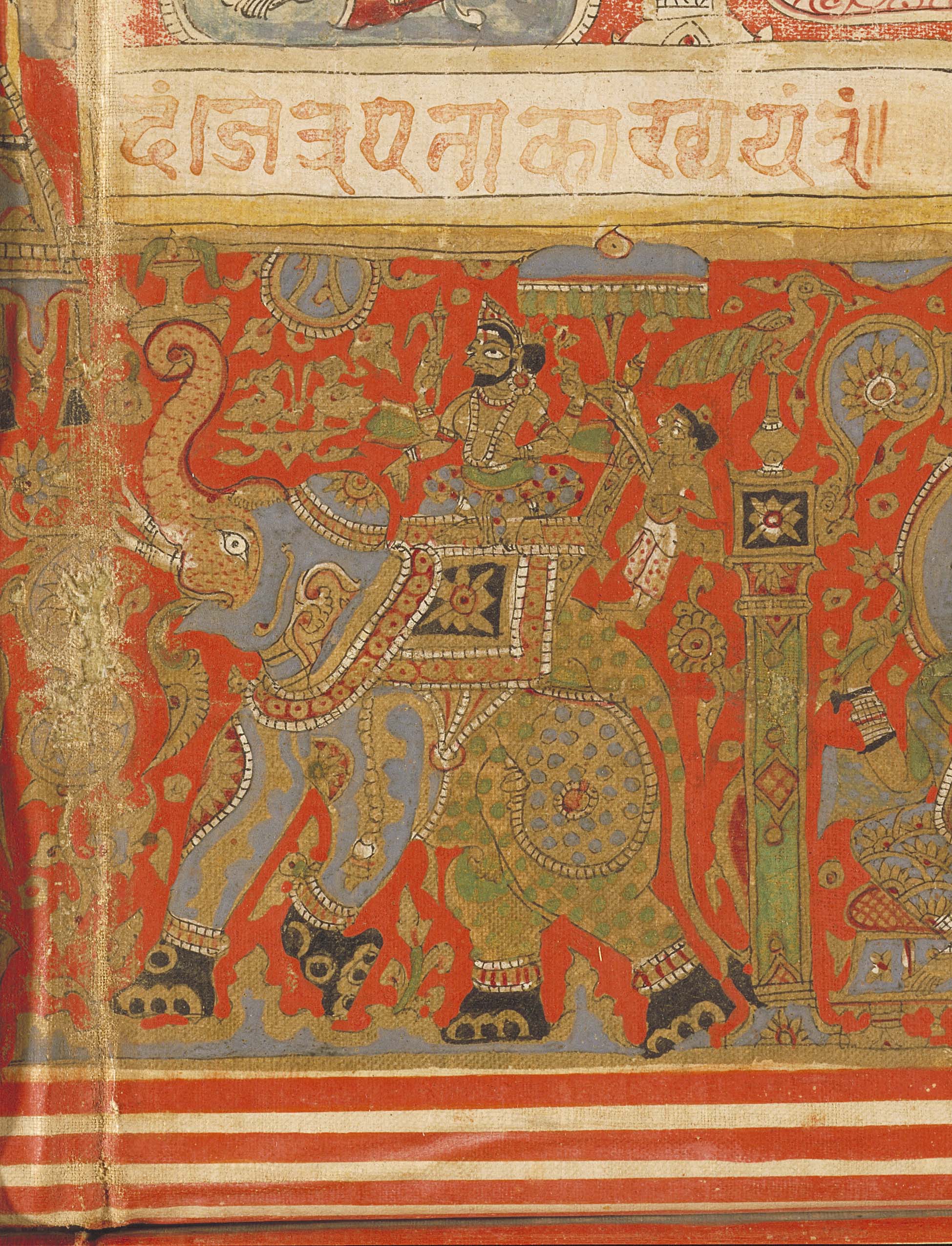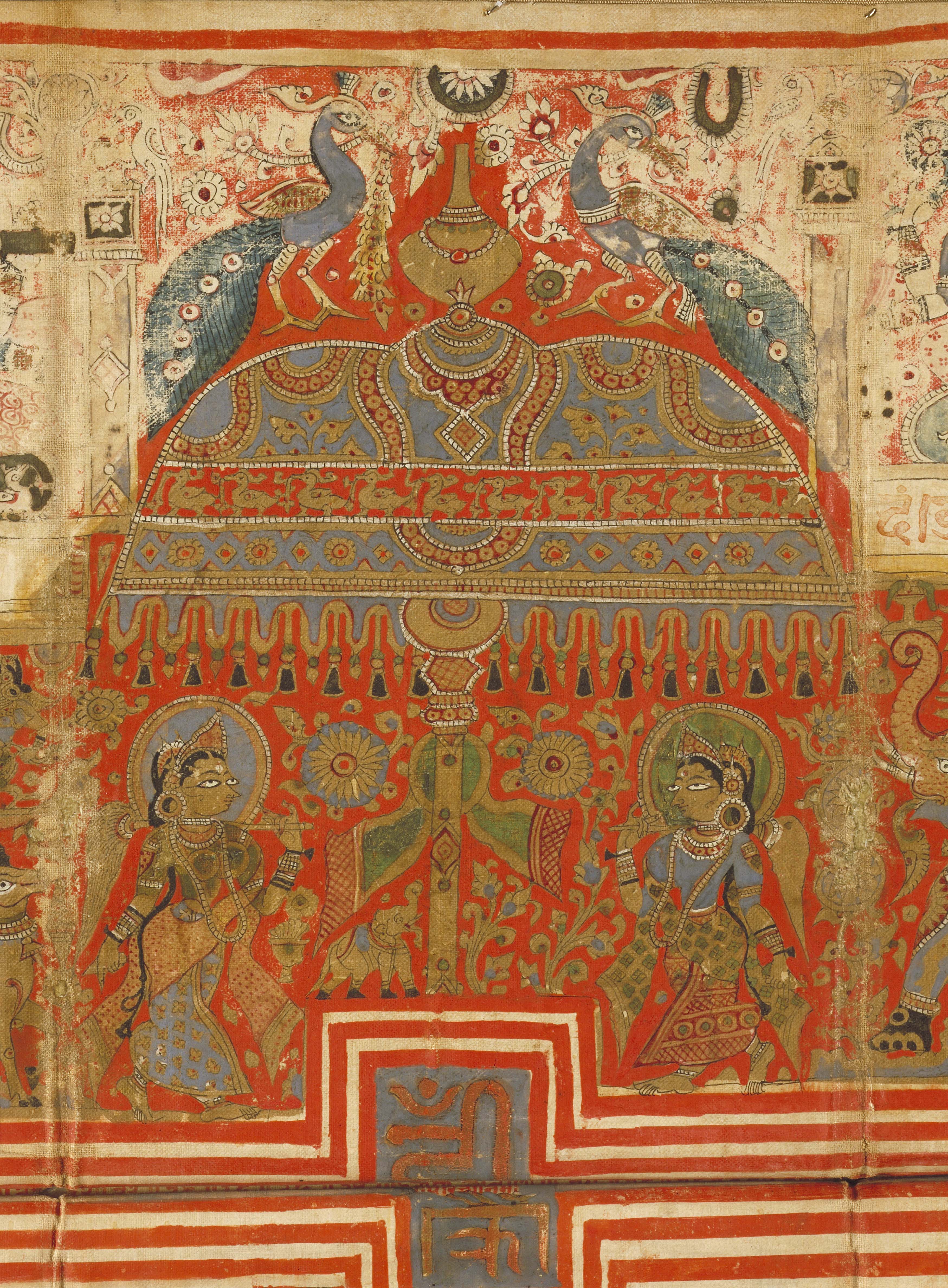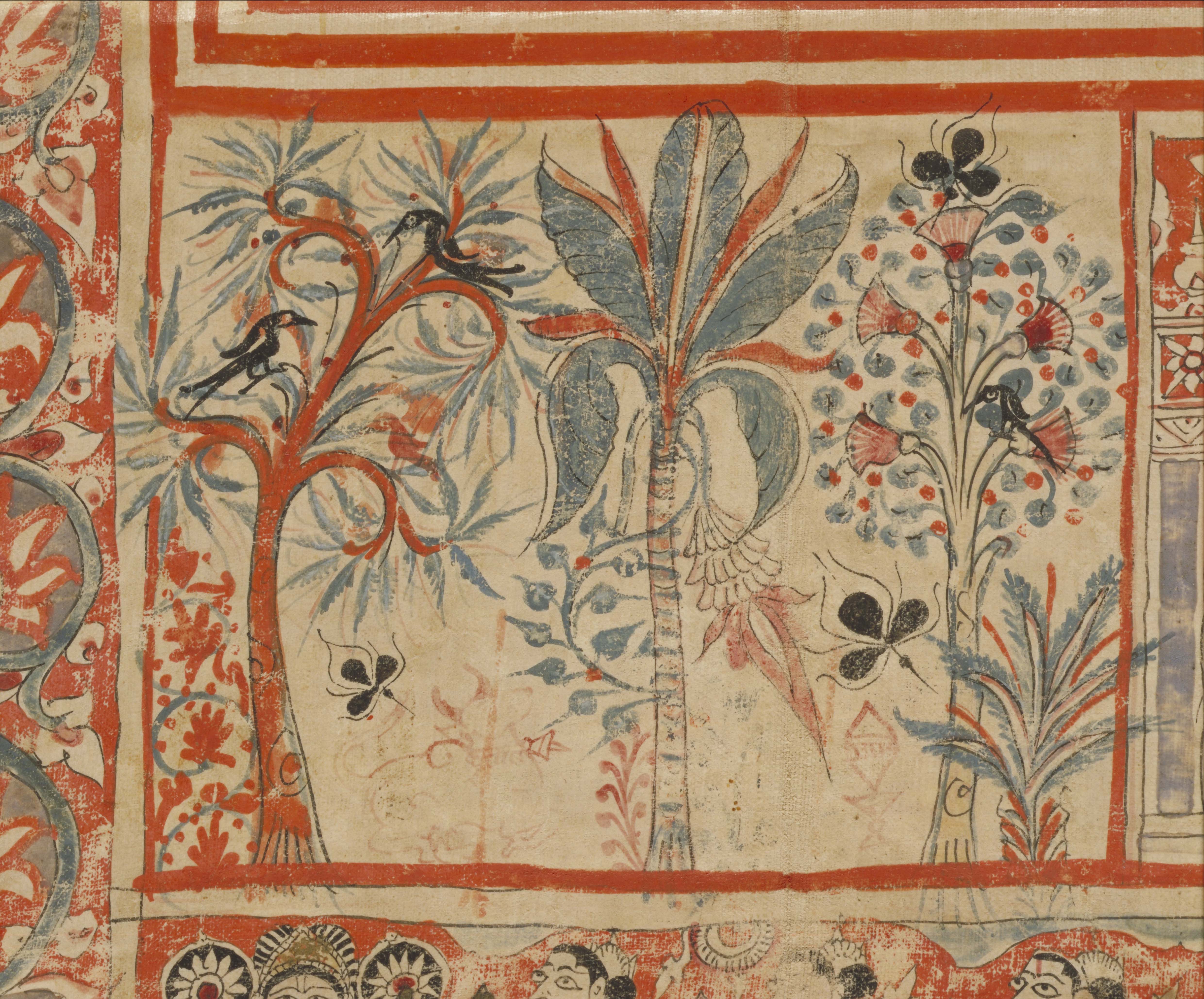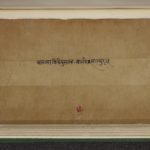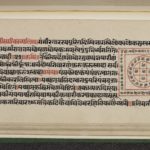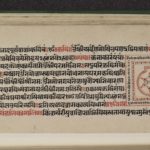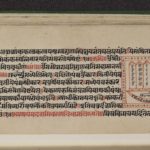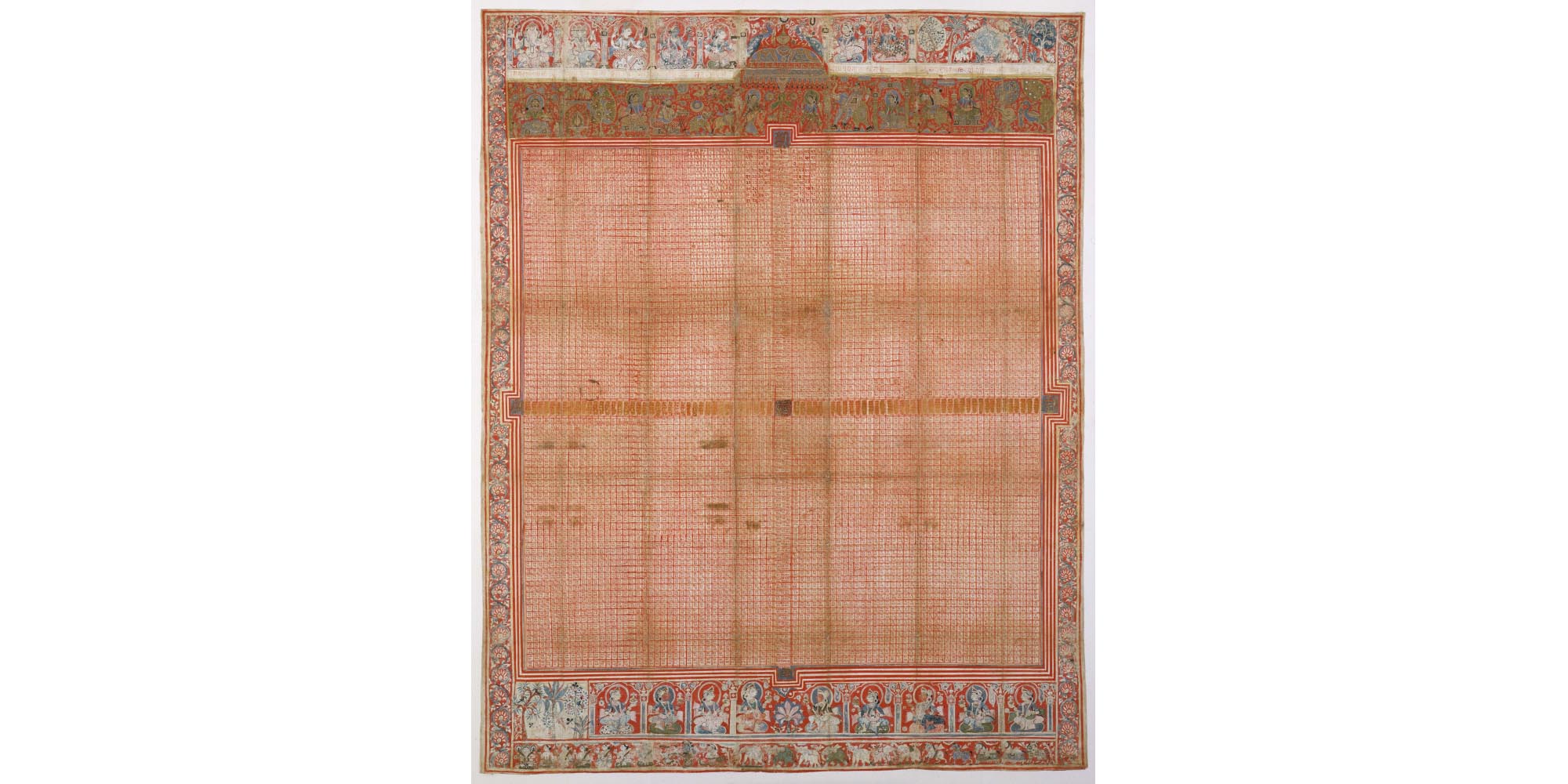
This Jain yantra is a rather rare painting from two viewpoints.
Firstly, it is very old, dating back to around 1447 CE. Not many paintings from such an early period have survived.
Secondly, it is a rare example in terms of content. Yantras are formed of complex diagrams combining all or some of the following:
- numbers
- magic formulas or mantras
- figures of human beings, Jinas, gods and goddesses.
As well as the conventional numbers, mantras and figures, this example shows the emblems of planets and the Universal Monarch or cakravartin. It therefore has cosmological themes.
Yantras are either paintings on paper or cloth or metal objects. Very few have survived.
The earliest surviving yantra paintings date from the 15th century and come from Śvetāmbara environments. Three main varieties are known from a rather large number of artefacts:
- the sūri-mantra-paṭa, which shows a religious teacher seated in the centre and 24 Jinas in surrounding concentric rings
- the vardhamāna-vidyā-paṭa, depicting Mahāvīra or Vardhamāna in the centre.
- the ṛṣi-maṇḍala-paṭa – the ‘Circle of Sages’ – with the tantric syllable Hrīṃ at the centre of the 24 Jinas and usually one or more surrounding concentric circles showing various religious teachers.
Not all yantras fall into one of these groups. There are yantras centred on other Jinas or other religious figures. This yantra seems to be very unusual in not focusing on religious figures and in being a meditation aid to help gain victory in battle.
Yantras are used as meditation aids. Mendicants generally use them in rituals relating to promotion in the religious hierarchy.
The three types are associated with particular rites. The sūri-mantra is connected with the initiation ritual of a new ācārya and it is likely that monks used the vardhamāna-vidyā-paṭa in connection with the rank of upādhyāya. However, the ṛṣi-maṇḍala-paṭa does not seem to have such a specific association. Even so, mendicants use it for other rituals.
The narrow white strip below the top row of deities contains a red inscription in Devanāgarī script. The red ink has faded so much it is hard to make out. It seems to say:
saṃvat 1504 varṣe dīpotsavadine likhitaṃ pratiṣṭhitaṃ śrīKharataragcchādiśvara śrī [Ji]nabhadrasūri nāma jetrapatakākhyaṃ yantraṃ … saparivārasya jayatraṃ vanchita siddhaṃ // kuru kuru svāhā //
The narrow white strip below the top row of deities contains a red inscription in Devanāgarī script. The red ink has faded so much it is hard to make out. It seems to say:
In the year 1504 of the Vikrama era [= 1447 CE] on the day of the Festival of Lights [= Dīvālī] [Ji]nabhadra-sūri, the head of the Kharataragaccha[,] consecrated this magical diagram called ‘victory banner’. May it bring victory, may it fulfil all desires of …. and his family. Svāhā.
Comments
Although the name of the religious teacher is incomplete, it can be guessed as Jinabhadra-sūri. He was one of the most famous leaders of the Kharatara-gaccha, a Śvetāmbara monastic order especially powerful in Gujarat and Rajasthan. Jinabhadra-sūri established a large number of religious institutions and temple-libraries. He is mentioned in many manuscript colophons as having encouraged lay people to commission manuscript copies. He also consecrated numerous Jain images. He was extremely active in Jaisalmer and Patan, from where this object may have come.
The day on which this object was consecrated is especially auspicious. In the Jain religious calendar the Festival of Lights, known as Dīpotsava or more commonly as Dīvālī, is a very important date. It is the date of Mahāvīra’s nirvāṇa.
The lay donor for whom this victory banner was made is unknown. His name would have been written in the blank space. The unfilled space could mean that it was ‘a readymade painting awaiting a donor’ (Granoff, Peaceful Liberators, catalogue number 99).
Glossary
Top row
The figures in the top row are deities, from left to right:- Gaṇeśa
- Brahmā
- Śiva
- Viṣṇu
- Sarasvatī
- two unidentified deities.
Second row
In the next row from the top, the focal point is the central parasol under a pot and two peacocks. This is a royal symbol. Under the parasol is a kind of column with a banner, which could be a victory pillar. From left to right, either side of the parasol:- elephant
- bull
- horse
- general
- queen
- minister
- wheel
- conch shell.
Central panel
The main part of the painting consists of a grid pattern divided into quadrants by two columns crossing in the centre. These two columns include both numerals and sacred formulas or mantras. All the other tiny squares contain only numbers. At the four cardinal points and in the centre are larger squares in blue with mystic syllables:- on the top, in the centre – HRĪṂ
- in the middle – AUṂ
- at the bottom – KRAUṂ
- on the left – KLĪṂ
- on the right – TTĪṂ.
Bottom rows
The two bottom rows contain delicate and refined paintings. The first row has a sequence of nine figures, which are difficult to identify. They are possibly personifications of the nine treasures – nidhi – of a cakravartin. The second row has a line of elephants and horses on the right. Both are royal animals and traditional components of an Indian army so their presence on a victory banner is not out of place. Elephants and horses are also associated with the movements of planets in Jainism. The other animals linked to planetary motion are bulls and lions. On the left side of the second row is a chain of nine figures. They are the nine celestial elements – nava-grahas – which are frequently shown on Jain yantras. From left to right they are:- the sun – sūrya – a seated figure carrying two discs
- the moon – candra
- Mars – maṅgala
- Mercury – budha
- Jupiter – guru
- Venus – śukra
- Saturn – śani – coloured grey or black
- Rāhu, who causes eclipses, is the easiest to recognise even though only his head appears in a chariot, which represents the movements of the moon
- Ketu, a half-human, half-snake figure, is shown with a trident and a bird.
- Source:
Victoria and Albert Museum
- Shelfmark:
IM 89-1936
- Author:
unknown
- Date of creation:
1447
- Folio number:
not applicable
- Total number of folios:
not applicable
- Place of creation:
western India
- Language:
not applicable
- Medium:
watercolour on cloth
- Size:
86 x 59.4 cms
- Copyright:
V&A Images/Victoria and Albert Museum, London
- Image Copyright:
- +
- aAbhavya
- aAbhinandana
- aAbhiṣeka
- aĀcāra
- aĀcārāṅga-sūtra
- aĀcārya
- aAchalbhrata
- aAḍhāī-dvīpa
- aAdharma
- aAdho-loka
- aAdhyayana
- aAdvaita Vedānta
- aĀgama
- aAghātīya
- aAghātīya-karman
- aAgnibhuti
- aAgra
- aĀhāra
- aAhiṃsā
- aAhimsa Day
- aAjita
- aAjīva
- aAkampit
- aĀkāśa
- aAkbar the Great
- aAkṣaya-tṛtīyā
- aAlauddin Khalji
- aAlbert Einstein
- aAllah
- aAlms
- aĀlocanā
- aAloka-ākāśa
- aAmāri
- aAmbikā or Kūṣmāṇḍinī
- aAnagāra
- aAnanta
- aAnarthadaṇḍa
- aAnaśana
- aAnekānta-vāda
- aAṅga
- aAniconism
- aAnojjā
- aAntarāla
- aAntarāya-karma
- aAṇu
- aAṇu-vrata
- aAnukampā
- aAnuprekṣā
- aAnusvāra
- aApabhraṃśa
- aAparigraha
- aAra
- aĀrambha
- aĀrambhaja
- aĀratī
- aArdhamāgadhī Prākrit
- aArhaṃ
- aArhat
- aArśana-āvaraṇīya-karma
- aĀrta-dhyāna
- aĀryikā
- aĀryikā Jñānamati
- aĀśātanā
- aĀścarya
- aAscetic
- aAsceticism
- aAshram
- aAspiration
- aĀsrava
- aAṣṭa-maṅgala
- aAṣṭāpada
- aAstikāya
- aAstrolabe
- aAsura
- aAtheism
- aAticāra
- aAtiśayakṣetra
- aAtithisaṃvibhāgavrata
- aĀtma-vāda
- aĀtman
- aAuṃ
- aAurangzeb
- aAuspicious
- aAusterity
- aAvadhāna
- aAvadhi-jñāna
- aĀvaraṇī-yakarman
- aAvasarpiṇī
- aAvatāra
- aAvidyā
- aAxiom
- aĀyāga-paṭa
- aĀyambil
- aĀyu-karma
- aĀyurveda
- bBabur
- bBāhubali
- bBaladeva
- bBālāvabodha
- bBandha
- bBasadi
- bBazaar
- bBhadrankarvijay
- bBhagavant
- bBhaktāmara-stotra
- bBhakti
- bBhale
- bBharata
- bBhāṣā
- bBhāṣya
- bBhaṭṭāraka
- bBhāva
- bBhāva-pūjā
- bBhāvanā
- bBhavana-vāsin
- bBhavya
- bBhavyatva
- bBhaya
- bBhoga-bhūmi
- bBhogopabhoga
- bBodhi
- bBollywood
- bBrahmā
- bBrahma-deva
- bBrahmacārī
- bBrāhmaṇa
- bBraj Bhāṣā
- bBright fortnight
- bBritish Raj
- bBuddha
- bBuddhi-sagar
- bBuddhism
- bBuddhist
- cCaitya
- cCaityavāsin
- cCakravartin
- cCakreśvarī
- cCāmara
- cCandanā
- cCandragupta
- cCandraprabha
- cCanon
- cCāritra
- cCāritramohanīya-karman
- cCarũrī
- cCaste
- cCaturvidha-saṅgha
- cCaturviṃśati-stava
- cCāturyāma
- cCE
- cCelibacy
- cCha
- cChadmastha
- cChastity
- cCheda-sūtra
- cChristian
- cChristianity
- cClergy
- cCloning
- cColophon
- cCommentary
- cConch
- cConfession
- cCongregation
- cConsecration
- cCosmology
- cCremation
- cCrore
- cCult
- cCūrṇi
- dDādā-guru
- dDalit
- dDāna
- dDaṇḍa
- dDark fortnight
- dDarśana
- dDarśanamohanī-yakarman
- dDaśa-lakṣaṇa-parvan
- dDeity
- dDelhi Sultanate
- dDerāsar
- dDeśāvakāśika-vrata
- dDetachment
- dDevanāgarī
- dDevānandā
- dDevarddhi-gani
- dDevotee
- dDhamal
- dDhanuṣ
- dDhāra
- dDharma
- dDharma-dhyāna
- dDharma-sāgara
- dDharmastikaya
- dDhātakīkhaṇḍa
- dDholak
- dDhyāna
- dDiaspora
- dDig-vrata
- dDigambara
- dDīkṣā
- dDisciple
- dDīvālī
- dDivya-dhvani
- dDNA
- dDoctrine
- dDogma
- dDonor
- dDoṣa
- dDravya
- dDravya-pūjā
- dDrone
- dDuṣamā
- dDuṣamā-duṣamā
- dDuṣamā-suṣamā
- dDveṣa
- dDvīpa
- eEast India Company
- eEightfold Path
- eEkānta-vāda
- eEkendriya
- eElder
- eElders
- eEschatology
- eEtc up to
- fFarmān
- fFast
- fFatehpur Sikri
- fFestival
- fFestschrift
- fFiruz Shah
- fFly-Whisks
- fFolio
- fFour Noble Truths
- gGaccha
- gGaṇa
- gGaṇadhara
- gGanadharavada
- gGaṇeśa
- gGaṇin
- gGarba
- gGarbha
- gGarbha-gṛha
- gGaruḍa
- gGati
- gGene
- gGenomics
- gGhātī-yakarman
- gGhātīya
- gGhaznavid
- gGhiyasuddin Tughlaq
- gGhurid
- gGloss
- gGotra-karma
- gGujarāt
- gGujarati
- gGuṇa
- gGuṇa-sthāna
- gGuṇa-vrata
- gGupti
- gGuru
- gGuruṇī
- hHagiography
- hHajj
- hHaṃsa
- hHaribhadra
- hHariṇaigameṣin
- hHasta
- hHeresy
- hHiṃsā
- hHindi
- hHindu
- hHinduism
- hHīravijaya
- hHoroscope
- hHrīṃ
- hHumayun
- hHymn
- iIconoclasm
- iIconography
- iIdol
- iIndian Independence
- iIndology
- iIndra
- iIndrabhūti Gautama
- iIndriya
- iInitiation
- iIntercession
- iInvocation
- iIQ
- iIslam
- iIslamicate
- iIṣṭadevatā
- iĪśvara
- jJagat
- jJahangir
- jJain
- jJaina Devanāgarī
- jJaina Śaurasenī
- jJaina-dharma
- jJainaśāsana
- jJainness
- jJaisalmer
- jJamāli
- jJambū-dvīpa
- jJames Burgess
- jJanma
- jJanma-kalyāṇa
- jJarā
- jJāti
- jJina
- jJina-āgama
- jJina-bhavana
- jJina-bimba
- jJina-mātā
- jJinacandra-sūri
- jJinadatta
- jJinaprabha
- jJīva
- jJñāna
- jJñāna-āvaraṇīya-karma
- jJñāna-āvarṇiya
- jJñānsundar
- jJyotiṣka
- kKāla
- kKālakācārya-kathā
- kKālidāsa
- kKalpa-sūtra
- kKalpa-vṛkṣa
- kKalyāṇaka
- kKalyanvijay
- kKamaṇḍalu
- kKamaṭha
- kKarma
- kKarma-bhūmi
- kKarma-grantha
- kKarma-prakṛti
- kKarma-vāda
- kKarmon
- kKarnataka
- kKaṣāya
- kKathā
- kKāvya
- kKāya
- kKāyotsarga
- kKeśa-loca
- kKetu
- kKevala-jñāna
- kKevalin
- kKhalji
- kKharatara-gaccha
- kKnowledge
- kKriyā
- kKriyā-vāda
- kKṛṣṇa
- kKṣamā-śramaṇa
- kKṣapakaśreṇi
- kKṣatriya
- kKṣullaka
- kKulakara
- kKundakunda
- kKunthu
- lLabdhi
- lLaity
- lLakh
- lLāñchana
- lLands of Action
- lLaukāntika
- lLavaṇa-samudra
- lLeśyā
- lLiṅga
- lLinguistics
- lLoka
- lLoka-ākāśa
- lLoka-puruṣa
- lLoka-vāda
- lLotus
- lLotus lake
- mMadhya-loka
- mMahā-videha
- mMahā-vrata
- mMahābhārata
- mMahāmastakābhiṣeka
- mMāhārāṣṭra
- mMāhārāṣṭrī Prākrit
- mMahattarā Yākinī
- mMahāvīr Jayantī
- mMahāvīra
- mMakāra
- mMakkhali Gośāla
- mMalli
- mMāna-stambha
- mManaḥ-paryāya-jñāna
- mMaṇḍala
- mMaṇḍapa
- mMandit
- mMaṅgala
- mMantra
- mMantras
- mManuṣya-loka
- mMarāṭhī
- mMārgaṇā
- mMartyr
- mMarudevī
- mMaṭha
- mMati-jñāna
- mMauryaputra
- mMecca
- mMendicant lineage
- mMetarya
- mMiracle
- mMithyādṛṣṭi
- mMohandas Gandhi
- mMohanīya-karma
- mMokṣa
- mMonastic order
- mMonasticism
- mMonk
- mMonotheism
- mMosque
- mMount Meru
- mMount Sammeta
- mMṛgāvatī
- mMughal
- mMuhammad
- mMuhammad bin Tughlaq
- mMuhpattī
- mMūla-sūtra
- mMūlaguṇa
- mMumbaī
- mMuni
- mMunisuvrata
- mMurad Bakhsh
- mMūrti-pūjaka
- mMuslim
- mMysticism
- nNābhi
- nNāga-kal
- nNāgapurīya Tapā-gaccha
- nNāgarī
- nNāma-karma
- nNamaskāra-mantra
- nNami
- nNandīśvara-dvīpa
- nNandivardhana
- nNandyāvarta
- nNāraka
- nNāraki
- nNasalisation
- nNātha
- nNavrātrī
- nNaya-vāda
- nNemi
- nNidāna
- nniggaṃthāṇa vā 2
- nniggaṃtho vā 2
- nNigoda
- nNihnava
- nNikṣepa
- nNirgrantha
- nNirjarā
- nNirvāṇa
- nNiryukti
- nNiṣidhi
- nNitya
- nNiyati
- nNo-kaṣāya
- nNudity
- nNun
- oOcean of milk
- oOmniscience
- oOrdination
- ppa°
- pPadmaprabha
- pPadmāsana
- pPadmāvatī
- pPādukā
- pPalanquin
- pPalette
- pPañca-muṣṭi
- pPāṇḍava
- pPaṇḍit
- pPandit Dalsukh D. Malvania
- pPandit Sukhlalji
- pPāṇipātra
- pPāpa
- pParamātman
- pParameṣṭhin
- pPāraṇā
- pParigraha
- pPariṇāma
- pParīṣaha
- pParokṣa
- pPārśva
- pPārśvanātha
- pParyāya
- pParyuṣaṇ
- pPaṭa
- pPatan
- pPātra
- pPenance
- pPersian
- pPhala
- pPhilology
- pPicchikā
- pPilgrimage
- pPīr
- pPolymath
- pPoṣadha
- pPossession
- pPothī
- pPrabhas
- pPradakṣiṇā
- pPradeśa
- pPrākāra
- pPrakīrṇaka-sūtra
- pPrākrit
- pPramāda
- pPramukhā
- pPrati-vāsudeva
- pPratikramaṇa
- pPratimā
- pPratiṣṭhā
- pPratyākhyāna
- pPratyakṣa
- pPravacana
- pPrāyaścitta
- pPrayer
- pPre-modern
- pPreach
- pPredestination
- pProtestant
- pProvenance
- pPudgala
- pPūjā
- pPujārī
- pPukharavara-dvīpa
- pPuṇya
- pPūrva
- pPuṣkara-dvīpa
- pPuṣpadanta
- pPyre
- qQur’an
- rRāga
- rRāhu
- rRainy season
- rRajasthan
- rRajasthani
- rRājimatī
- rRajoharaṇa
- rRajput
- rRāma
- rRāmāyaṇa
- rRangoli
- rRās-garbā
- rRasa
- rRathanemi
- rRatna-traya
- rRātri-bhojana
- rRaudra-dhyāna
- rRecto
- rRelic
- rRenunciation
- rRetroflex
- rRevatī
- %Ṛg-veda
- rRite
- rRosary
- %Ṛṣabha
- %Ṛṣabhanātha
- rRupee
- sSaciyā Mātā
- sSādhu
- sSādhvī
- sSāgāra
- sSaint
- sŚaivaism
- sŚaka-saṃvat
- sSallekhanā
- sŚalya
- sSamacatuṣṭha
- sSamādhimaraṇa
- sSamaṇi
- sSāmarambha
- sSamavasaraṇa
- sSāmāyika
- sSaṃbhava
- sSamiti
- sSaṃjñā
- sSaṃkalpaja
- sSaṃsāra
- sSamudghāta
- sSaṃvara
- sSaṃvega
- sSamyak-cāritra
- sSamyak-darśana
- sSamyak-jñāna
- sSamyaktva
- sSaṃyama
- sSanctuary
- sSandalwood
- sSaṇgha
- sSanskrit
- sSant
- sŚānti
- sSapta-bhaṅgi-naya
- sSārambha
- sSarasvatī
- sSarvajña
- sSāsan-devi
- sŚāsana-devatā
- sŚāstra
- %Ṣaṭ-jīvanikāya
- sSatī
- sSatīmātā
- sSatya
- sSchism
- sScribe
- sScripture
- sSect
- sSecularism
- sŚenāī
- sSermon
- sŚeṣavatī
- sSevā
- sSeven fields of donation
- sShah Jahan
- sShantidas Jhaveri
- sShrine
- sSiddha
- sSiddha-śilā
- sSiddhacakra or Navadevatā
- sSiddhānta
- sSiddhārtha
- sSiddhi
- sSikh
- sSikhism
- sŚikṣā-vrata
- sŚīla
- sSin
- sSindh
- sŚītala
- sŚiva
- sSkandha
- sSomanatha
- sŚraddhā
- sŚramaṇa
- sŚrāvaka
- sŚrāvakācāra
- sŚrāvikā
- sŚreyāṃsa
- sŚrī
- sŚrīvatsa
- sŚruta-jñāna
- sŚruta-pañcamī
- sSthānaka-vāsin
- sSthāpanācārya
- sSthāvara
- sSthavira
- sSthiti
- sStrīmukti
- sStūpa
- sSubcontinent
- sSudarshana
- sŚuddhi
- sSudharma
- sŚūdra
- sSufism
- sSukha
- sŚukla-dhyāna
- sSulasā
- sSultan
- sSumati
- sSundarśrī
- sSupārśva
- sSūri
- sSuṣamā
- sSuṣamā-duṣamā
- sSuṣamā-suṣamā
- sSūtra
- sSuyam me ausam! Tenam bhagavaya evamakkhayam
- sSvādhyāya
- sSvāhā
- sSvastika
- sŚvetāmbara
- sŚvetāmbara Terāpanthin
- sŚvetāmbaras
- sSwan
- sSyād-vāda
- tTabla
- tTantra
- tTapā-gaccha
- tTapas
- tTāraṇ Svāmī Panth
- tTattva
- tTattvārtha-sūtra
- tTemple
- tTemple-city
- tThe Enlightenment
- tTheology
- tThree worlds
- %Ṭīkā
- tTilaka
- tTīrtha
- tTīrthaṃkaranāma-karman
- tTīrthankara
- tTransliteration
- tTrasa
- tTrasa-nāḍī
- tTriśalā
- tTriṣaṣṭi-śalākā-puruṣa-caritra
- tTti bemi
- tTughlaq
- tTunk
- uUdumbara
- uUniversal History
- uUpādhyāya
- uUpāṅga
- uUpaniṣads
- uUpāsaka
- uUpasarga
- uUpāśraya
- uŪrdhva-loka
- uUtsarpiṇī
- uUttarādhyayana-sūtra
- vVāhana
- vVaimānika
- vVairāgya
- vVaiṣṇava
- vVaiśramaṇa
- vVaiśya
- vValabhī
- vVanaspatikāya
- vVandana
- vVaṇik
- vVarṇa
- vVāsudeva
- vVāsupūjya
- vVayubhūti
- vVeda
- vVedanīya-karma
- vVegetarianism
- vVehicle
- vVernacular
- vVerso
- vVidyā
- vVidyā-devī
- vVihāra
- vVijñapti-patra
- vVikrama-saṃvat
- vVikṛti
- vVimala
- vVinaya
- vVipāka
- vVirji Vora
- vVirodhaja
- vVīrya
- vVisarga
- vViṣṇu
- vVītarāga
- vVizier
- vVotive
- vVow
- vVrata
- vVS
- vVyakta
- vVyantara
- vVyasana
- yYakṣa
- yYakṣī
- yYantra
- yYaśoda
- yYaśovijaya
- yYati
- yYātrā
- yYoga
- yYoginī
- yYojana
This is a yantra, a type of meditation aid. This one is a victory banner, which is extremely rare. It was probably produced to help gain victory in battle for the meditators. It consists of a central panel with two rows of smaller illustrations at the top and bottom. There is a heavily faded inscription in the narrow white band beneath the top row of deities.
Top row
The figures in the top row are deities, from left to right:
Second row
In the next row from the top, the focal point is the central parasol under a pot and two peacocks. This is a royal symbol. Under the parasol is a kind of column with a banner, which could be a victory pillar.
From left to right, either side of the parasol:
- elephant
- bull
- horse
- general
- queen
- minister
- wheel
- conch shell.
They probably represent the ‘jewels’ of the universal monarch – cakravartin.
Central panel
The main part of the painting consists of a grid pattern divided into quadrants by two columns crossing in the centre. These two columns include both numerals and sacred formulas or mantras. All the other tiny squares contain only numbers.
At the four cardinal points and in the centre are larger squares in blue with mystic syllables:
- on the top, in the centre – HRĪṂ
- in the middle – AUṂ
- at the bottom – KRAUṂ
- on the left – KLĪṂ
- on the right – TTĪṂ.
Two borders of stylised flowers adorn the vertical sides.
Bottom rows
The two bottom rows contain delicate and refined paintings.
The first row has a sequence of nine figures, which are difficult to identify. They are possibly personifications of the nine treasures – nidhi – of a cakravartin.
The second row has a line of elephants and horses on the right. Both are royal animals and traditional components of an Indian army so their presence on a victory banner is not out of place. Elephants and horses are also associated with the movements of planets in Jainism. The other animals linked to planetary motion are bulls and lions.
On the left side of the second row is a chain of nine figures. They are the nine celestial elements – nava-grahas – which are frequently shown on Jain yantras. From left to right they are:
- the sun – sūrya – a seated figure carrying two discs
- the moon – candra
- Mars – maṅgala
- Mercury – budha
- Jupiter – guru
- Venus – śukra
- Saturn – śani – coloured grey or black
- Rāhu, who causes eclipses, is the easiest to recognise even though only his head appears in a chariot, which represents the movements of the moon
- Ketu, a half-human, half-snake figure, is shown with a trident and a bird.





























































































